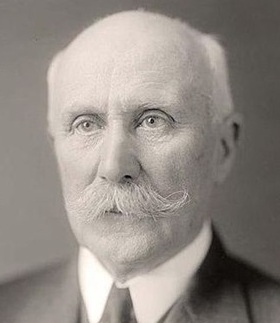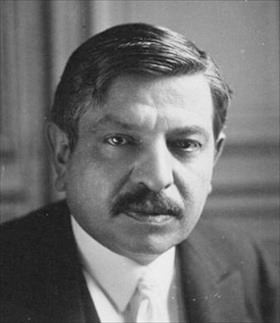PÉTAIN ASSUMES NEAR-ABSOLUTE POWER IN FRANCE
Vichy, France • July 11, 1940
On July 10, 1940, the French National Assembly meeting in the municipal opera house in Vichy, France, a small resort town 200 miles/322 kilometers south of German-occupied Paris, ceded its power and authority to Premier Philippe Pétain, the 84‑year-old Maréchal of France and World War I hero. On this date, 1 day later, Marshal Pétain, bearing his new executive title “Chief of State” and exploiting the absence of opposition députés, delineated his near-absolute powers and abrogated all laws of the predecessor Third Republic that were incompatible with the constitution of the new French State (État français). Retained was the feckless, cabinet-like Council of Ministers headed by Pétain, with twice-elected former Prime Minister Pierre Laval later named its vice president. The council’s basic membership had been established 3 days after hard-stepping German troops entered the French capital, unchallenged, on June 14, 1940. Pétain’s État français was a wholly dependent client state of Nazi Germany in the aftermath of the Franco-German armistice signed at Compiègne northeast of Paris on June 22, 1940.
The Vichy regime quickly took on clear authoritarian—even fascist—characteristics. Pétain indefinitely suspended the National Assembly, whose lawmaking function was assumed by a compliant Council of Ministers. Forswearing publicly any intention of becoming “a Caesar,” Pétain by January 1941 held virtually all governing power in France: executive, legislative, and judicial powers, either de jure or de facto.
Pétain’s government used its power to order harsh measures against its citizens and foreign residents, including establishing media censorship, criminalizing freedom of expression (“felony of opinion”), and instituting compulsory labor for able-bodied men and women. Ever more harsher measures were applied to Jews living in France. In September 1940 Jewish-owned shops were required to display yellow signs bearing the words “entreprise juive.” Later that month on September 27, 1940, under German orders, French police began collecting census data on all 330,000 Jews in France. A Vichy edict in October forbade Jewish ownership and management of their enterprises and excluded Jews from the army and certain professions such as medicine, law, and teaching. The next year, March 29, 1941, Vichy created the Commissariat Général aux Questions Juives to coordinate repression of Jews in both the occupied and free zones (see map below). Not surprisingly French police conducted France’s first roundup (rafle) of Parisian Jews (about 3,700 mostly Polish Jews) on May 14, 1941.
Worse things were to come. On German orders a second French rafle of Parisian Jews on August 20–23, 1941, netted 4,230, French- and foreign-born alike. Ever more Jews—13,152—entered police custody in the “Vel’ d’Hiv” dragnet, or la grande rafle, on July 16–17, 1942 (Opération Vent Printanier, or Spring Breeze), and they, too, were dispatched eastward, mainly to Auschwitz-Birkenau but some to Sobibór, both extermination camps in Nazi-occupied Poland. Twenty-four people who resisted arrest were shot. In all, between June 1942 and the end of July 1944, 67,400 French, Polish, and German Jews were deported from France, among them 11,000 children, some less than 2 years old. Fewer than 3,000 of these deportees returned alive.
In late January 1943 Vichy authorities (with German help) established the Milice française, a right-wing paramilitary militia to combat members of the French armed resistance, originally quasi-guerrilla bands living off the land known as the Maquis, though the term has come to embrace all resistance fighters (maquisards). By 1944 Vichy’s Milice had over 35,000 members, unsavory participants in incidents of torture, summary executions, murders, and roundups of Jews and members of the French Resistance. Clandestine U.S. and British operators helped the Maquis with supplies and agents. By early September 1944, after invading Allies had forced the Germans to evacuate the French capital and had opened a second front on the Mediterranean coast (Operation Dragoon), Pétain loyalists, including some miliciens, fled Vichy and reestablished themselves in exile in Southwestern Germany.
Partitioned France, 1940–1944, and Two Prominent Vichyites, Marshal Philippe Pétain and Pierre Laval
 |
Above: Slightly smaller than the state of Texas, metropolitan France was partitioned between Axis occupiers (Nazi Germany and Fascist Italy) and Vichy French collaborators between 1940 and 1944. The German military zone (zone occupée) in the north and west covered the larger part of France and contained most of France’s population, industrial wealth, and best viticultural (wine-growing) area. It also included France’s civic and cultural capital, Paris. The Italian zone in the southeast was tiny and of limited importance. The “Free Zone” (zone libre), which was governed by Vichy France (État français), enjoyed nominal sovereignty under its hard-right chef de État, Marshal Pétain, even to the extent of maintaining a 100,000-strong Armistice Army to keep internal order. (In the German-occupied zone there was no French military force.) Situated in Central and South Central France, Vichy France comprised roughly 45 percent of metropolitan France and was by far the poorer part of the country. Separating the 2 zones was a heavily patrolled 745‑mile/1,199 kilometer demarcation line, which broadly followed the course of the river Loire and which the German military could open and close at will. In fact, a travel pass (Ausweis) was required to travel from zone occupée to zone libre. Portions of France fell under the military administration of German-occupied Belgium, while parts of Alsace-Lorraine in the east were integrated into neighboring German administrative districts, their inhabitants made German citizens. A 12½‑mile/22 kilometer strip of land, the zone interdite (“forbidden zone”), ran along the whole of France’s Atlantic coast. After Allied landings in French North Africa in November 1942 (Operation Torch), German and Italian troops swept in to occupy Vichy France. Henceforth, the “South Zone” (zone sud) in its reincarnation was ruled by the German armed forces as part of occupied France, although Pétain’s Vichy regime continued to remain nominally in charge.
 |  |
Left: Blue-eyed and waxen skin, Philippe Pétain (1856–1951) was a French general who reached the distinction of Maréchal of France, later authoritarian Chief of State of Vichy France from 1940 to 1944. With the French parliament adjourned indefinitely, Pétain assumed constitution-making power. Over the years Pétain and his Vichy regime collaborated ever more closely with their German overlords, France’s hereditary enemy. His wartime actions—his peace at any price—resulted in his postwar conviction for treason (by a one-vote majority) and death sentence. Gen. Charles de Gaulle, who was President of the Provisional Government of the French Republic, commuted the sentence to life imprisonment due to the doddering marshal’s age (89) and his military contributions in World War I. Pétain was exiled to an island prison off the French Atlantic coast, where he died at the age of 95.
![]()
Right: Stocky, swarthy, and shrewd, the son of a butcher, Pierre Laval (1883–1945) was 4‑time prime minister of France, twice serving the Vichy regime as head of government (chef du gouvernement). An admirer of totalitarian government, Laval embraced the muscular fascism of Nazi Germany, the destruction of bourgeois parliamentary democracy, and the rollback of Third Republic liberal reforms. He signed orders sanctioning the deportation of foreign Jews from French soil to Nazi death camps. He was also the formal head of the sinister Milice française. On September 7, 1944, what was left of Pétain’s collaborationist government relocated to Sigmaringen, a Vichy enclave in Southwestern Germany. After falling into U.S. hands, Laval was turned over to the French provisional government in late July 1945. Tried for treason and violating state security, he was convicted and sentenced to death. After a failed attempt at suicide (the cyanide had lost its full potency), Laval was executed, half-conscious and vomiting, by firing squad on October 15, 1945.
British Newsreel of Marshal Henri Philippe Pétain on First Day of Trail for Treason at Paris’s Palais de Justice, July 23, 1945
![]()

 History buffs, there is good news! The Daily Chronicles of World War II is now available as an ebook for $4.99 on Amazon.com. Containing a year’s worth of dated entries from this website, the ebook brings the story of this tumultuous era to life in a compelling, authoritative, and succinct manner. Featuring inventive navigation aids, the ebook enables readers to instantly move forward or backward by month and date to different dated entries. Simple and elegant! Click
History buffs, there is good news! The Daily Chronicles of World War II is now available as an ebook for $4.99 on Amazon.com. Containing a year’s worth of dated entries from this website, the ebook brings the story of this tumultuous era to life in a compelling, authoritative, and succinct manner. Featuring inventive navigation aids, the ebook enables readers to instantly move forward or backward by month and date to different dated entries. Simple and elegant! Click 











